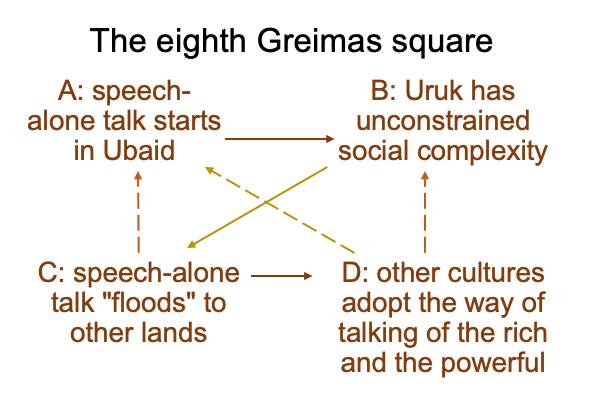0174 In chapter six, Loke considers Noah. Noah receives the tarnished title, “Image Bearer of God”, through descent from Adam. The title passes through the doctrine of Traducianism, so the lineage must be genetic. However, the tarnished title also seems to pass beyond Seth’s family line, so to speak, into those animals who are anatomically humans, who laugh at and ridicule Noah for imagining that God would or could punish them. Here, the passage must not be genetic. Maybe it is genealogical. Maybe it is the acquisition of speech-alone talk instead of hand-speech talk.
0175 Does Noah’s flood cover the whole earth?
It depends on how you define the word, “earth”.
0176 Here is a Greimas square that seems appropriate.

0177 The “earth” is the focal word (A). It is what is covered by Noah’s flood.
In contrast to the Genesis use of the word, “earth” (A), is the world of southern Mesopotamia (B). To everyone ridiculing Noah, the world of southern Mesopotamia is all there is. It is their “earth”. So, Noah’s flood destroys this “earth”.
The genealogies (of sorts) immediately following the flood (C) speak against the idea that southern Mesopotamia is the entire earth. The table of nations makes sense when Noah’s children are accepted into the royalty of other peoples based on the celebrity of Noah’s achievement. As far as Genesis is concerned, nations are founded because they receive direct descendants within the Image Bearer of God lineage. It is as if these jurisdictions are not relevant until then.
0178 What does this imply?
Southern Mesopotamia is the center of the world, if not the entire “earth”, until that catastrophic flood, which is noted as a break in the Sumerian king list (D).
This list (D) contrasts with the Genesis table of nations (C) because it represents the records of a public institution. It is entirely possible that the family of Seth lives entirely within public institutions in the Ubaid and Uruk (and later, Sumerian) traditions. So, the Genesis story of Noah’s flood is an insider’s view of a very public shaking of the Uruk political order.
The Sumerian king list (D) suggests that Noah’s flood (A) is indeed, not planetary, since the kingship descends (from heaven) soon afterwards. In this, the list (D) speaks against a literal reading of the Genesis story (A). Also, the list (D) supports the notion (what Loke calls Type C concordism) that Genesis belongs to the literature of the ancient Near East.
This list (D) complements the world of southern Mesopotamia (B), because the king list represents the establishment of order within the Sumerian world. The Sumerian king list is written centuries after the flood. The flood marks a break. The flood denotes the end of a Plutonic year, so to speak.
0179 What else does this imply?
Consider the following Greimas square.

0180 Speech-alone talk and Adam’s lineage starts in the Ubaid (A). Speech-alone talk spreads out from southern Mesopotamia to nearby hand-speech talking cultures.
The subsequent Uruk period (B) contrasts with this beginning. Uruk clearly differentiates from surrounding Neolithic cultures, who now practice speech-alone talk, but are far behind in terms of realizing the creative potential of this new tool of the intellect.
0181 Noah’s flood marks an ecological catastrophe, partially brought about by deforestation in northern Mesopotamia and partially brought about by (what modern insurance policy makers call) divine intervention. During the Uruk archaeological period, speech-alone talk floods into other lands. Egypt, Iran, the Indian subcontinent, China, the Mediterranean, eastern Europe and the lands north of the Caspian Sea, manifest social changes due to exposure to speech-alone talk.
Noah’s flood covers the “earth” of southern Mesopotamia.
The speech-alone talk flood covers the entire Earth.
This “flood” of speech-alone talk (C) speaks against Uruk as composing the entire earth (B) and complements the origination of speech-alone talk with the Ubaid (A).
0182 Consequently, the conditions for the table of nations, following Noah’s flood, are set (D) as the lands surrounding the Uruk, each in its own way, start to undergo trends towards unconstrained social complexity. These trends (D) contradict the exclusive claim of Sumeria as the only place where labor and social specialization increase wealth and power (A). At the same time, these trends (D) complement the achievements that already have occurred in southern Mesopotamia (B).
By the time that the Sumerian Dynastic coalesces, at 2800 U0′, dynastic civilization begins in Egypt and unconstrained social complexity is seeded along the Indus River Valley and the great rivers of China. On the Russian steppes, the proto-Indo-European cultures are already undergoing a transformation into formidable migratory chiefdoms. The Bronze Age is apparent in the Aegean. Even in the Americas, there are indications that speech-alone talk has arrived, on the western coast of what is now Ecuador.
0183 The entire Genesis sequence of stories and genealogies, stretching from Adam to Terah, coincides with the period from the start of the Ubaid (0 U0′) to the end of Ur III (3700 U0′).
If that is the case, then why isn’t the text longer and more elaborate? Why don’t the first eleven chapters of Genesis clearly blend in with the written historical material of the ancient Near East?
One suggestion is found in chapter 13C of An Archaeology of the Fall.
On one hand, when Abram starts his journey, he leaves Sumerian civilization behind. Not all of it, but nearly all of it. The story of the Tower of Babel is no accident. After Ur III, Sumerian is a dead language, known only in writing.
On the other hand, Sarai, remembers the fairy tales that her mother taught her.
